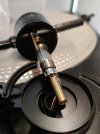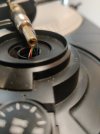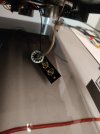Sounds like that's how it should normally be. The tonearm tube is being used as an electrostatic shield. There should be no buzz when you're touching the tonearm. Ideally the entire cable run up to the outputs should be shielded (but never making contact anywhere), so there is slight room for improvement by DIY means here - we'll think about that later.
The main problem area that'll cause hum issues tends to be poor contact at cartridge or headshell (if any). The contact surfaces are often silver plated and will tarnish over the years. Also, there are some cartridges like Grados that will connect L and R ground returns together internally, which results in an internal ground loop, so maybe check that with a multimeter, too.
Remove cables from cartridge carefully using small needlenose pliers. Take a reference photo beforehand so you know which ones goes where (there's a standard color code though AFAIK).
BTW, I am pretty sure that this wannabe "DJ" 'table dates from the late '90s / early 2000s. At a massive 3.75 kg, I am sure the plinth is leaving much room for improvement via bitumen mat and whatnot.



